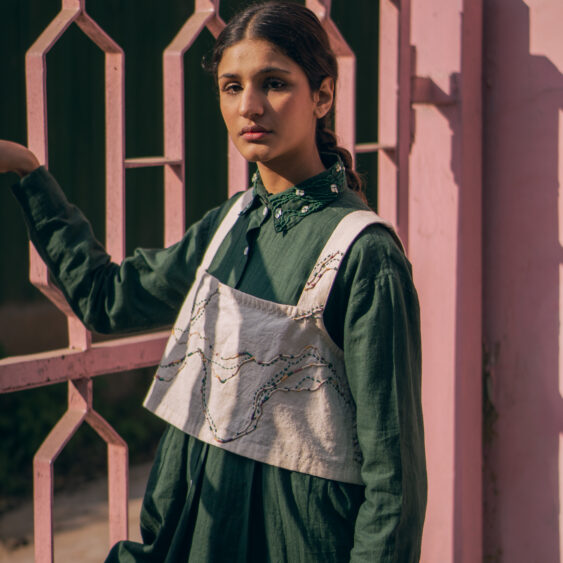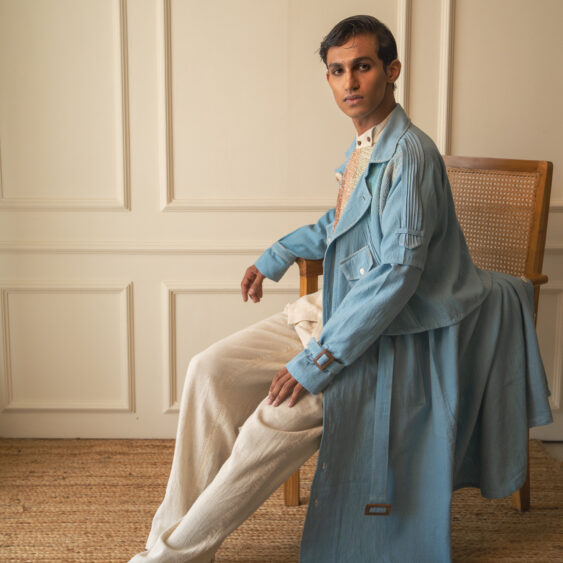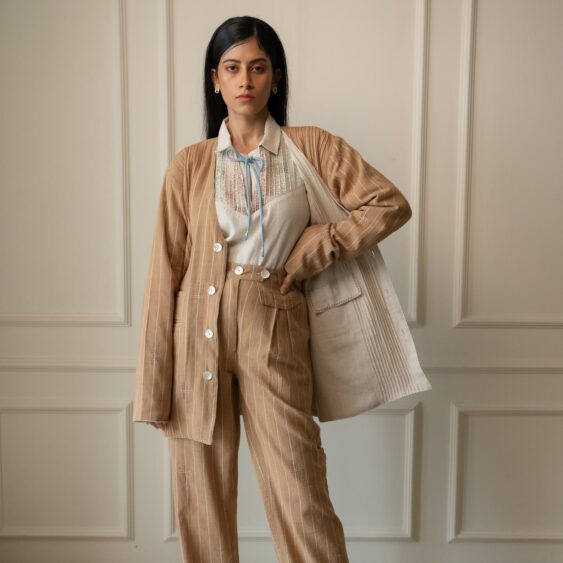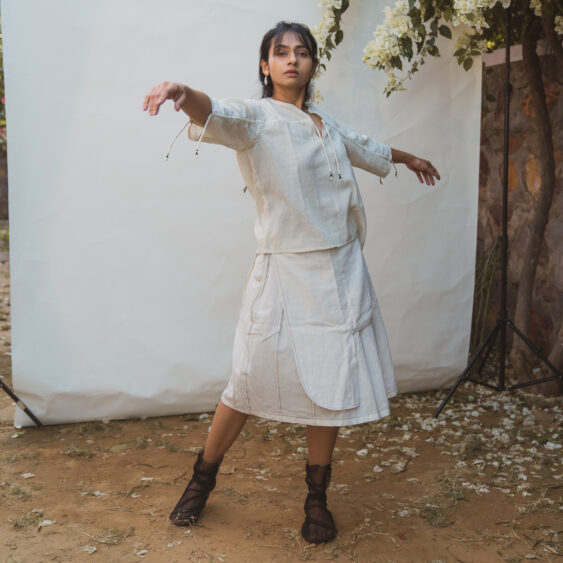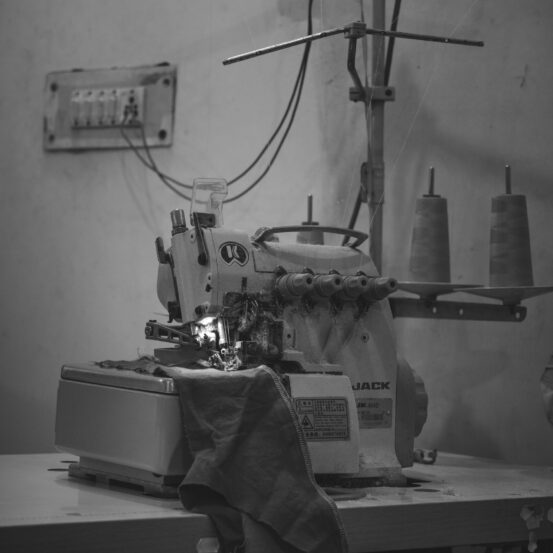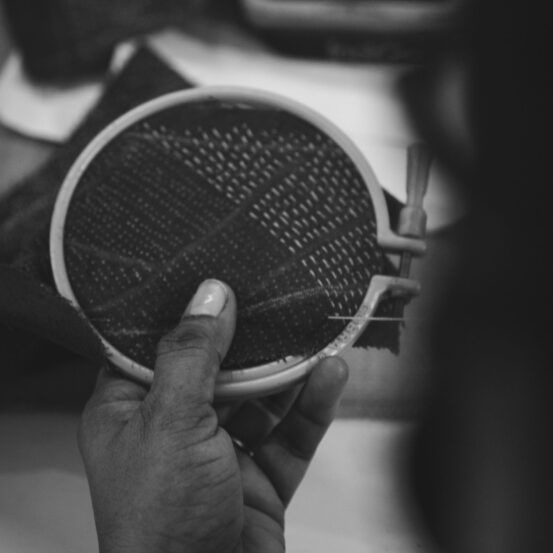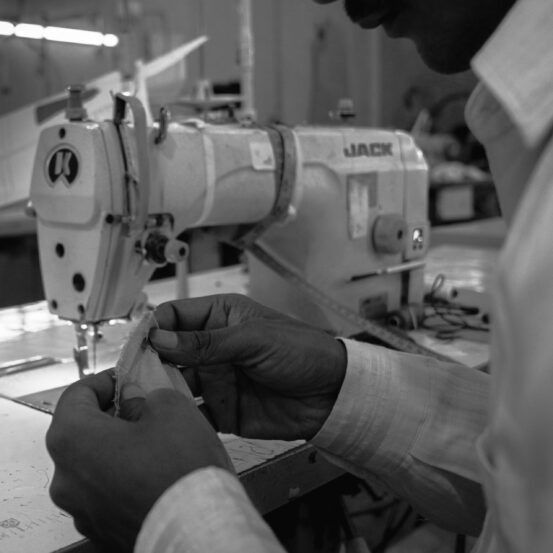

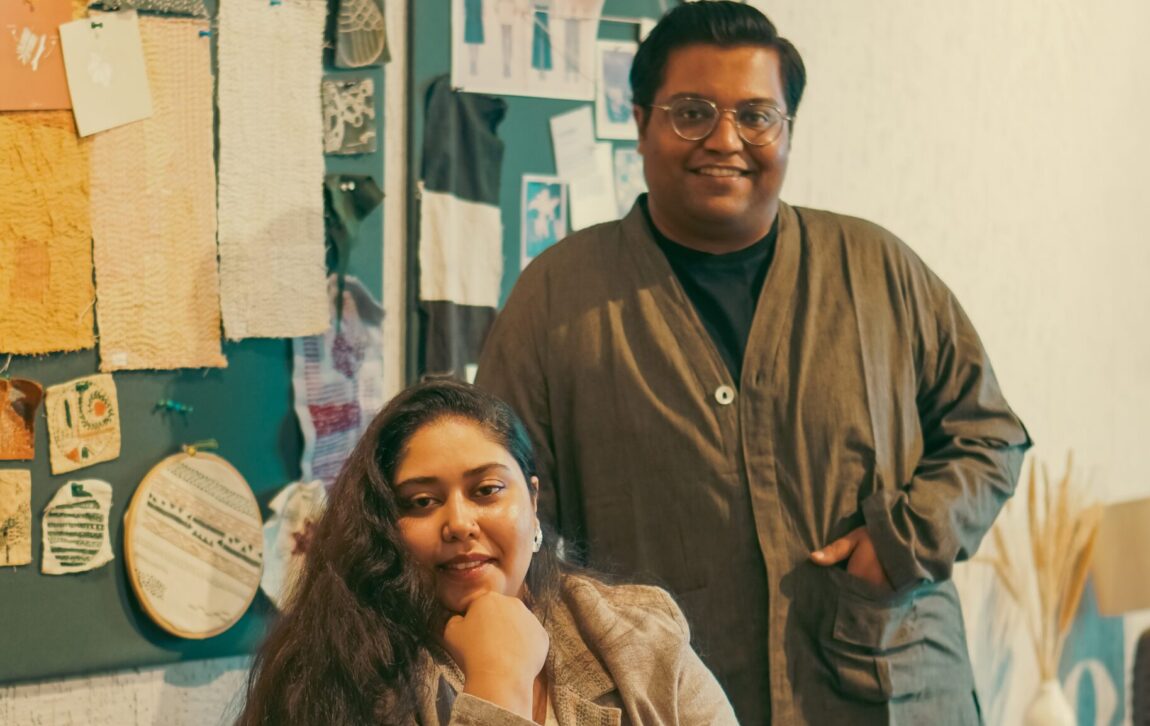
BRAND NAME - Lafaani
FOUNDER - Drishti Modi & Rashmick Bose
STARTED IN - 2021
USP - Circular Apparel
A contemporary apparel brand that champions circularity from the start to end, Lafaani aims to revolutionise the way we view sustainable fashion. Using indigenous fabrics and traditional crafts that amplify the country’s rich textile heritage, Lafaani’s modern yet timeless designs uplift artisanal communities through their work. Blur The Border speaks to Drishti and Rashmick - co-founders of Lafaani on their design process and the challenges of building a conscious brand in India.
Drishti & Rashmick's Picks
Who is the one influencer you wish to see wearing/using your products?
Dia Mirza

Is there a podcast/book/social media handle that you’ve found helpful for your business?
Ethically Yours - Podcast






What’s your dream collaboration?
Stella McCartney
BTB: What is the story behind the name ‘Lafaani’?
DRISHTI: When we were thinking of the brand, there were a couple of keywords that we wanted to integrate - one was a word about legacy or about being indigenous or about being circular. Lafaani is actually an Urdu word that means immortality and we caught it while watching a movie. It perfectly captures what we were envisioning for the brand - for the product to be immortal in the customer’s wardrobe.
RASHMICK: We thought ‘Lafaani’ could deeply link us to our culture, our past and our traditions. We felt that it fit perfectly with the brand and its ethos and also goes along with us through our circularity journey as a whole.
BTB: What inspired you to start the brand?
DRISHTI: Both Rashmick and I do not actually come from a fashion background, we’re sustainability professionals with masters in environmental studies and resource management. Back when we were studying or working, our understanding of sustainability was all piecemeal - be it through the conversations we were having or observing what other brands in this space were doing. Someone was doing great work in upcycling but only using polyester based fabrics or someone was doing great stuff with indigenous crafts and textiles but launching 20 collections a year. All of that inspired us to start the brand - to look at sustainability in the fashion space holistically.
BTB: How did working in sustainability help get Lafaani off the ground?
DRISHTI: Our academic program was quite intensive. We got a lot of on-field exposure, where Rashmick worked in the water space and I worked in the waste and agricultural sector. I worked on a project in Andhra Pradesh where the state wants to convert into a wholly regenerative agricultural state by 2025. I got to work with cotton farmers directly to figure out market linkages and understand the challenges they faced. Throughout our journey, we realised that as a country, we have always been rooted in sustainability. The newer terms may be fancy but it is essentially what we were doing 300 years ago. Working with these farmers, different artisan and migrant groups helped me understand the supply chain which was pivotal in forming the brand.
RASHMICK: We were also in contact with many grassroots organisations. When we started to jot down the specifics of the brand and production, these really came in handy because we always wanted to take a collaborative approach. Our journey was always aimed towards building the brand, maybe we didn’t know it at the beginning, but it always led to Lafaani.
BTB: Tell us about your products and what, according to you, sets your brand apart from competitors.
DRISHTI: Sustainability is at the core of what we do and we have four design principles that are essentially our guardrails - upcycling, multi-functionality, craft connections and design for longevity. We use these principles as constraints which gives us an interesting opportunity to work out creative solutions for the designs. As for the product itself, it is a no-brainer that it needs to have a timeless appeal and be as multifunctional and utilitarian as possible. We are also a biophilic process oriented brand, we love everything handcrafted, everything natural.
RASHMICK: We try to make our products to be all body and all size inclusive, but at the same time we do not want to make the garment anti-fit. Our designs are contemporary pieces that suit everyone’s taste and something you can wear at any occasion. We offer sizes up to 4XL off the rack but we are also open to all kinds of customisation as we want the customer to make it something of their own. Our garments are also 100% biodegradable made with all natural materials with a supply chain that is completely localised from the start. We work with indigenous varieties of cotton like Kala cotton or Brown cotton and a lot of our pieces are Kora - which means undyed or unbleached. Even the coloured ones are completely naturally dyed without any chemical fixers. All our pieces are hand embroidered, hand finished and the trims we use like the buttons or the buckles are either wooden, mother of pearl or coconut shell - essentially all natural.
DRISHTI: We also do not use elastane or metal or any sort of plastic, which is why all our pieces are 100% biodegradable. That does present a little bit of constraint even to the design team but it is something that our customers are appreciating, so it makes us happy. So yeah, I think all of these factors are what sets us apart.
BTB: How has the reception been for your products - in India and internationally?
DRISHTI: We are very happy with the journey. We just turned two in October but we have been able to build a robust retail network - both domestically and internationally. The products are well received but we have a super long way to go. We are very happy about the journey also being very organic - whether it is the styling opportunities or the retail collaborations, it has all come to us on its own. Our impact is small because we are a small business and as we grow our impact will also increase.
RASHMICK: When we put our products out, the one thing we want to convey is that sustainability is not a special characteristic of your garment - it should be the norm. So it was very important to us to put the story of our process out and let people understand that bit. I think somewhere we have done the right job because we have been able to collaborate and partner with other organisations whom we had not even expected to do so early on. Especially since we are not from the industry, we are complete outsiders in that sense and that makes it all the more special.
My last purchase was …
Rashmick - A perfume from Maison De Fouzdar






What is the show/book/song you are currently obsessing over?
Rashmick - On Earth We're Briefly Gorgeous by Ocean Vuong
Drishti - Coke Studio’s latest season






In my spare time, you’ll find me…
We are usually cafe-hopping or watching a play.






Name 4 other homegrown small brands you are loving right now.
Drishti - Oceedee Shoes, Slow Studio, Equivalence
Rashmick - Thaely Shoes
BTB: How do you maintain a balance between the trends in the market and your own artistic vision for Lafaani?
DRISHTI: We do look at trend forecasts simply as cue points just to see what we are doing, because aesthetics at the end of the day are what really matter. Our north star is still sustainability and its considerations, but trends are something that we look at on-and-off to see where everybody is heading. And we have often seen that with the conversations we are having and the observations we make, we are somehow in sync with the trends and we are very happy about that.
RASHMICK: I think with having timeless aesthetics, something or the other always comes back to trend, so that works out for us in a way without trying very hard. Also, I believe that with trends we get to learn about new and innovative technologies and design techniques.
BTB: Tell us about the artisans who make the clothes for Lafaani.
DRISHTI: I think we have been extremely lucky with the people we work with - our team of embroiderers, a pattern master and our tailor masters, and a talented team of women artisans who do all the handwork at the workshop. We give them a lot of creative freedom in the production process and often co-create. We might just give them a little direction and a few instructions so they know what they are supposed to do. We have a lot of inputs coming to us from our embroiderer or from our tailor who see these small details when they are creating the pieces and help us fine-tune the designs.
RASHMICK: Even our partner organisations like Yali and Karghewale are very aligned with us in terms of their vision and their goals. We get full supply chain transparency as to who is the weaver and who is dyeing the fabric, the amount of work they put in, and certifications and more. They reach out to us if there are any new developments by the weavers in terms of materials or techniques, which we pick up swatches of to see if there are any products we can create with. Despite being very small, these organisations have the same vision of not treating the artisans as mere doers, but rather foster the spirit of entrepreneurship in them. Even with our in-house team, we started with one embroidery woman artisan and now she has become our leader who trains everybody else. We see a lot of ownership of the brand in her work where she does all the QC by herself and we don’t even have to ask or check by ourselves again. It’s been wonderful to see growth for everyone involved in the brand so far.
BTB: How do you decide what fabrics to work with for your collections?
DRISHTI: Honestly, it is not a difficult process for us as we have researched in depth as to the impacts and opportunities that cotton cultivation in India holds. The indigenous varieties of cotton like the Kala cotton from Kutch or the Andhra cotton or the Brown cotton from Karnataka, hold great potential as these are not water thirsty or resource hungry crops. They can grow in arid areas, can grow entirely rain-fed and are also naturally pest and drought resistant, which is best for a country like ours and also with the climate inconsistencies we are anticipating. Using these varieties basically helps the money flow in a very small radius and create self-sufficient and decentralised local economies, which is also what the pandemic taught us is the way to move forward.
RASHMICK: It is also a way for us to honour local geographies and local traditions. The weaving techniques of these fabrics also enables us to create a trans-seasonal range every time - it could be thicker for outerwear or thinner for daily staples. We have also worked with cotton denim which is much thicker and can be easily worn during the winters.
BTB: Elaborate on the circularity aspect of the brand.
DRISHTI: First is biodegradability - all our products are entirely biodegradable. We try to encourage our consumers to repair their garment if it develops a hole or a tear with a little repair kit that is customised to each product. We want to foster a sense of belongingness of the garment to the customer and to get rid of that disposable mindset/culture. We also add a wash care label to each garment so the consumer knows exactly how to wash it and how it will extend its life.
We do try to incorporate minimal waste pattern cutting, but of course there are some designs that will have some pre-retail waste. We collect all of it from the shop floor to make small accessories. So there is a smaller loop within the production phase but overall the whole production to consumption space is a loop and that is how we understand circularity.
BTB: Describe your creative process - from ideation to the final product.
DRISHTI: Tons of research, brainstorming, observing, sampling and prototyping. We dive deep into the ‘why’ factor - if we are adding a certain detail, then is it for aesthetic or utility, is it solving any purpose? We also have conversations like if someone is buying a top from Collection Four, do they also have to buy our pants or can they pair it with something they already own. If we are making an outerwear essential piece should it be in a neutral beige or an off-white or some other colour. We don’t want our customers to do mindless consumption. These are difficult conversations but we have realised that we come to the best possible outcomes with our designs.
RASHMICK: There are also a few limitations with our processes, for example we use natural dyes for our garments which causes a certain degree of bleeding everytime there is a wash. So when it comes to embroidery, we take into account that the colour of the thread is such that even with every bleed, there will not be much effect on the embroidery per se. We are constantly exploring new woven fabrics and experimenting with different concepts with our team, which helps us understand what we can and cannot do at the current moment.
BTB: What does a typical 9-5 day look like in the life of an entrepreneur like you?
DRISHTI: It is never 9-5, it is essentially all our waking hours, haha! Each day is very different from one another as we are a small but really dedicated team. There are certain things we try to do everyday consistently as a team such as touching base every morning to set the tone for the day and prioritise the agenda. We connect with the team at the workshop to understand if everything is smooth and going at the desired pace. Apart from this, Rashmick and I both make sure to take some time out everyday for research - it could be something in the space of sustainability or something interesting happening at a brand or just generally what’s going on around us.
RASHMICK: We are Remake ambassadors, so as a part of the Remake community, we have had the opportunity to expand our base in terms of creating a conversation around fashion and trying to tell our story. We try to keep up with the conversations that take place in the community.
BTB: As an entrepreneur, do you find that it is hard to take time out for yourself?
DRISHTI: We do, yes, but we are not complaining. The good thing is Rashmick and I have many shared interests like going and trying out food at cool new places or catching a play together or going to an exhibition.
RASHMICK: If we are going to Delhi, we will also check out any events happening there so that we can fit something in our schedule. That’s how we take little breathers. I think we are also quite happy the way things are and I wouldn’t say there is an imbalance of things.
BTB: What has been an accomplishment that you are the proudest of in your journey?
DRISHTI: We made it to the top seven in the India shortlist at the R| Elan presents The Circular Design Challenge this year. While we are a little sad that we did not make it to the top three, we are quite proud of the fact that everything we presented to the jury was very well received and we got great feedback from them as well.
RASHMICK: As a very young brand, we feel the achievements we want to accomplish are yet to come but the journey so far has been very good. We are growing as organically as possible by just letting our story out, and the fact that we are receiving a response from the other end is very reassuring, kind of telling us that we are on the right track.
BTB: Is there any other brand doing great work in this space that you would like to highlight?
DRISHTI: We really look up to this brand - Oshadi Collective. They own their entire supply chain right from their own farms to the final product and it is absolutely lovely.
BTB: What do you think the next five years look like for your business?
DRISHTI: A lot of hard work for sure. We are really looking to expand our retail network both domestically and internationally, as the appeal for a product like ours is much more overseas, though of course we feel India is catching up really soon. And we want to add meaningful partnerships and collaborations with like-minded organisations.
RASHMICK: We want to explore different artisan clusters and crafts. With transparency, we want to become innovative in terms of communicating our circularity so that our consumer can understand it easily and quickly.
DRISHTI: We have recently integrated a climate action API into a few of our products where it displays the positive climate action that is being done with respect to a purchase a consumer makes and the impact of the product while it is being made. The idea is to make it easier for the consumer to make mindful choices with simpler communication and hopefully this is a tool that will help them.
FOLLOW LAFAANI'S INSTAGRAM @thelafaanistudio
THANKS FOR READING!
HERE'S AN EXCLUSIVE 10% OFF TO SHOP FROM LAFAANI - BLURWITHLAFAANI10
